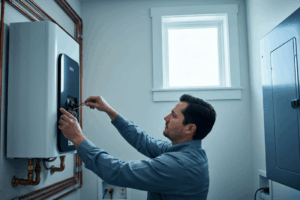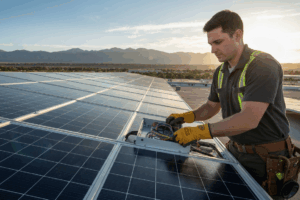
Working with 277/480V Systems: A Guide for Electricians
For many electricians, the world of 120/240V single-phase power is our bread and butter. It’s the lifeblood of every home in America. But step onto a commercial or industrial job site, and you enter a different league. The hum of machinery is louder, the conduits are bigger, and the numbers on the multimeter are significantly higher. Making the leap to successfully and safely working with 480V systems is a defining moment in an electrician’s career. It’s a move that opens doors to more complex projects, higher-paying roles, and a deeper understanding of the power that drives our modern world. If you’re ready to expand your expertise beyond residential work, understanding the landscape of higher-voltage systems is your first, most critical step.
The Great Leap: From Residential to Commercial Voltages
In the residential sphere, the conversation around voltage is fairly straightforward. But in commercial settings, the discussion of 208V vs 240V becomes much more common. While a 240V system is standard in homes (split-phase), a 208V single phase supply is often found in multi-unit dwellings and light commercial buildings. This single phase 208V voltage is derived from a three-phase wye system, a precursor to the larger systems you’ll encounter in industrial work. Even the typical air conditioner voltage can vary, sometimes requiring a 208V supply in a commercial context instead of the residential 240V.
Understanding these subtle but critical differences is the foundation for moving up to more powerful systems. While these voltages demand respect, they don’t carry the same inherent risks as their bigger cousin: the formidable 480V system.
Demystifying the 277/480V Wye System
The workhorse of most large commercial and industrial facilities in the United States is the 277/480V wye system. This configuration is efficient and versatile, providing two distinct voltages for different applications from a single service.
- The 277 Volt Supply: The 277 volt (often written as 277V) measurement is the voltage from any one phase conductor to the neutral wire. This voltage is almost exclusively used for high-efficiency commercial lighting, making mastery of 277V lighting circuits a core competency for commercial electricians.
- The 480V Supply: The 480V measurement is the phase-to-phase voltage. This is the power that runs large motors, industrial machinery, and heavy HVAC equipment.
While the wye system is most common, it’s also important to be able to identify other configurations, such as a high-leg delta configuration, which can present unique challenges and safety concerns. You might also encounter a 480V single phase (or single phase 480V) setup, although it’s less common. This type of 480V single phase service is often created on-site using a step-down transformer 480V to power specific equipment that requires it.
Where You’ll Find 480V: The Industrial Landscape
Stepping into a factory, processing plant, or large-scale data center means stepping into a 480V world. This is where your skills are truly put to the test. You’ll be responsible for the installation, maintenance, and troubleshooting of critical infrastructure, including:
- Industrial Switchgear: These massive lineups of breakers and switches are the heart of a facility’s electrical distribution, and working on them requires meticulous planning and an unwavering commitment to safety.
- Motor Control Centers (MCCs): Proper Motor Control Center wiring is crucial for controlling the dozens or hundreds of motors in a plant. A deep understanding of control logic and a precise 480V motor connection is essential.
- Panelboards and Conductors: The principles of 480V panelboard wiring and correct high-voltage conductor sizing are amplified at this level. Miscalculations don’t just trip a breaker; they can lead to catastrophic equipment failure and serious safety incidents.
Safety Is Non-Negotiable: NFPA 70E and High-Voltage Hazards
A common question from electricians moving into this space is, “what voltage is considered high voltage?” The definition varies by standard. For instance, OSHA regulations (e.g., 29 CFR 1910.269) often classify voltages over 600V as high voltage for work practices. The NEC, however, generally defines high voltage as over 1000V in contexts like Article 490 for equipment. So, while 480V technically falls under “low voltage,” the danger it presents is exponentially higher than residential systems. Therefore, any work on systems above 240V necessitates a rigorous hazard assessment, aligning with NFPA 70E principles, due to the significantly increased risk of severe shock and arc flash. We also must understand what is considered medium voltage (generally 1kV-35kV) to have a complete picture of the power spectrum.
The single greatest danger when working with 480V is the arc flash hazard. An arc flash is a violent, explosive release of energy that can cause severe burns, hearing loss, and death. This is why strict adherence to NFPA 70E compliance is not just a company policy—it’s a lifeline. Before any work is performed on or near energized 480V equipment, a thorough safety plan must be in place. The latest code updates continuously refine these requirements, highlighting how the 2023 NEC arc flash hazard warning requirements are different and placing greater emphasis on risk assessment.
Robust lockout/tagout procedures are the most critical defense against electrical hazards. There is no excuse for failing to de-energize and verify a zero-energy state. When energized work is unavoidable, wearing the correct category of high voltage PPE is mandatory. It’s crucial to stay current on how NFPA 70E 2024 updates have changed electrical job safety planning to ensure your practices are aligned with the highest safety standards. These evolving standards reflect a broader industry push to understand how the 2023 NEC improves electrical worker safety around all types of equipment.
Level Up Your Career with High-Voltage Skills
Making the transition to working with three-phase power systems and 480V is more than just a technical challenge; it’s a significant career advancement. Electricians with proven experience and a deep understanding of industrial power are always in demand. They command higher wages, have access to more specialized roles (like industrial maintenance, controls, or project management), and enjoy greater job security.
If you’re looking to move beyond the residential market and build a career in the commercial or industrial sector, mastering 480V systems is your path forward. It requires diligence, a commitment to continuous learning, and an absolute dedication to safety. The rewards, both professionally and financially, are well worth the effort. Ready to take the next step? Upgrade your skills for commercial work with our advanced courses.
Frequently Asked Questions
- What is the main difference between 208V and 240V power?
- The primary difference lies in their source. 240V is typically derived from a single-phase, split-phase system common in residential settings. In contrast, 208V is derived from a three-phase power system, representing the voltage between any two phases of a 120/208V wye system. This is why the debate over 208V vs 240V is common in light commercial applications.
- Can you have single-phase 480V power?
- Yes, while less common than three-phase 480V, single phase 480V power does exist. It’s usually created by tapping two legs of a three-phase service or, more often, by using a dedicated transformer to power specific equipment that requires 480V single phase input.
- Why is 277V used for lighting in commercial buildings?
- Using 277V for large-scale lighting installations is more efficient than using 120V. At a higher voltage, the current (amperage) required is lower for the same amount of power (wattage). This allows for the use of smaller conductors and reduces voltage drop over long circuits, saving significant material and installation costs in large buildings.
Disclaimer: The information provided in this educational content has been prepared with care to reflect current regulatory requirements for continuing education. However, licensing rules and regulations can vary by state and are subject to change. While we strive for accuracy, ExpertCE cannot guarantee that all details are complete or up to date at the time of reading. For the most current and authoritative information, always refer directly to your state’s official licensing board or regulatory agency.



